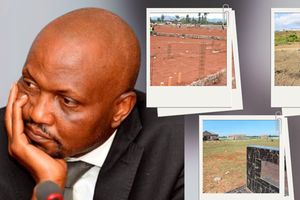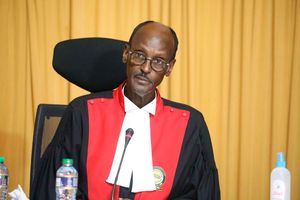
Voter registration in Elburgon town, Nakuru County. At least seven of the nine counties from Mount Kenya region where President Uhuru Kenyatta comes from recorded the worst growth rate in the recent voter listing.
| John Njoroge | Nation Media GroupCounties
Premium
Voter registration apathy hits Mt Kenya counties
At least seven of the nine counties from Mount Kenya region where President Uhuru Kenyatta comes from recorded the worst growth rate in voter listing in the just concluded mass voter registration.
Conversely, nine counties where ODM leader Raila Odinga and Deputy President William Ruto come from topped the highest growth rate in voter registration ahead of the August 9, 2022 General Election.
Both Mr Odinga and DP Ruto are the frontrunners in the race to succeed President Kenyatta.
The latest revelations are based on the data generated by the Independent Electoral and Boundaries Commission (IEBC) ahead of the general election from two enhanced voter registration (EVR) exercises also known as mass voter registrations.
Poor performers
An analysis of data generated from the two voter listings of November 2021 and January-February 2022 mass registration show that Murang’a, at 7 per cent, and Nyeri, Laikipia, Nyandarua and Kirinyaga — all at 8 per cent — recorded the worst performances.
The other poor performers are Embu at 9 per cent, Kiambu — the home county of President Kenyatta — recorded 10 per cent same as Tharaka Nithi, with Nakuru at 11 per cent.
But with President Kenyatta retiring after serving his two five-year terms, could this be a tell-tale sign of what the turnout in the 2022 general election could be for a region that will not be fronting a strong presidential candidate?
IEBC acting CEO Mr Marjan Hussein says that the problem lies with the youth who do not want to come out and register as voters.
“The information we have from our staff on the ground is that whenever the youth are told to register as voters, they always ask that we produce their MPs for them to register. This is a wrong notion,” said Mr Hussein.
No strong candidate
However, Mr Barasa Nyukuri, a governance and electoral expert, notes that the fact that the Mount Kenya region will have no strong candidate of its own in the August election may have contributed to the poor turnout.
“This could be an indication that voter turnout during the general election will not be as has been seen in the previous elections where the region has had a strong presidential candidate,” says Mr Nyukuri.
Ms Koki Muli, also an electoral expert, says that failure by the people to see progress from their leaders may have also contributed to poor voter registration.
“People get tired and in some cases resign to fate. You cannot be promising people development but when you get elected, you forget. It is time to convince people by walking the campaign talk,” says Ms Muli.
Top performers
A majority of the counties in the Northern Kenya recorded growth in the new voter listings. Garissa recorded 27 per cent, Turkana 26 per cent, Wajir 21 per cent, Mandera 20 per cent and Samburu 18 per cent.
The other top performers are West Pokot at 19 per cent, Uasin Gishu — the home county of DP Ruto — at 18 per cent, Baringo 17 per cent and Migori, a strong vote base for Mr Odinga, at 17 per cent.
But the latest data is a marginal movement in the number of registered voters in the two sets of counties.
For instance, among the worst performers, Murang’a added only 12,030 new voters to the 587,126 voters as per the 2017 register.
Nyeri has 12,402 new voters on top of the 456,949, Laikipia has 4,587 more compared to the 246,487 of 2017, Nyandarua increased its 335,634 voters by 14,273 and Kirinyaga has 3,230 above 349,836 already registered.
Embu will see its 309,468 voters increase by 5,829, Kiambu with 1,180,920 voters in 2017 recorded 39,859 new voters, Tharaka Nithi has increased its voters by 6,356 from 213,154 of 2017 and Nakuru by 37,788 from 949,618.
Garissa has its 163,350 voters as of 2017 increased to 207,435, Turkana from 1919,435 to 241, 583, Wajir voters increased to 196,466 from 162,902 with Mandera enhancing its tally from 175,642 to 211,098.
West Pokot has its figure at 214,574 from 180,232, Samburu from 82,787 to 98,081, Uasin Gishu from 450,055 to 530,993, Baringo from 232,258 to 271,977 and Migori now has 454,954 voters from 388,633.
The IEBC data also shows that Nairobi topped the list of counties that recorded the highest number of voter transfers at 97,004.
But the data does not indicate whether the voter movement was within the city county electoral areas or to the other counties.
The least movement of voters was recorded in Samburu County with 2,888 voters changing their areas of voting.
BVR kits
During the two voter listings, the commission deployed 7,720 biometric voter registration (BVR) kits countrywide to help in the registration.
The commission further stationed 52 BVR kits in Huduma centres, while 128 kits were allocated to vast counties and 2,900 kits were for backup, just in case some failed.
The kits in the wards, according to IEBC, were meant to ensure accessibility of registration centres by new voters “who would otherwise be discouraged by long distances to registration centres”.
During the exercise, registered voters had an opportunity to transfer their registration status to electoral areas of their choice and also correct erroneous registration details.





